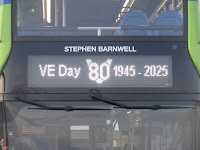Historic commercial vehicles - vans, trucks, lorries, fire engines, coaches/buses, steam wagons, many in bright-coloured liveries - lit up the Brighton seafront today, west of the pier. Arriving from around 10 am, they rolled in along Madeira Drive, sometimes stuttering, sometimes juddering, but every one clean and bright as a button, loved and cherished for their connections with our past.
The London to Brighton Historic Commercial Vehicle Run is an annual event celebrating Britain’s rich commercial motoring heritage. Organised by the Historic Commercial Vehicle Society (HCVS), the run showcases a diverse array of vintage commercial vehicles. The inaugural run took place on 13 May 1962, initiated by the HCVS, which itself was launched in 1958 following a rally at Beaulieu (where the National Motor Museum had been founded by Lord Montagu in 1952). The event has grown in popularity, with the 60th run in 2022 featuring 170 entrants.
Last year, 2024, HCVS relocated the starting point of the run from Crystal Palace to Brooklands Museum in Weybridge, Surrey. The change was implemented to avoid London’s Ultra Low Emission Zone (ULEZ) and various lorry restrictions, making it more accessible for vintage vehicles. Participants now follow a route through Cobham, Leatherhead, Dorking, Redhill, Horley, Balcombe, Cuckfield, Burgess Hill before joining the A23 at a Pycombe for the last stage to Madeira Drive on the seafront in Brighton.
Photos of some of today’s participants:
(Above) - a preserved British double-decker bus (1930s-1950s), a type that became iconic in UK public transport, especially in cities like London. The livery advertises Tampon’s Ales and Ty-Phoo Tea, both classic British brands.
(Top left) - a historic steam traction engine, a type of self-propelled steam-powered vehicle used primarily for agricultural and heavy haulage work in the late 19th and early 20th centuries.
(Top right) - a Fordson E83W, a light commercial vehicle produced by Ford between 1938 and 1957. This example is a flatbed pickup, often used for small deliveries and local business use. The E83W is known for its rounded cab, separate headlamps, and classic upright grille.
(Bottom left) - a classic single-deck coach, likely from the 1950s or 1960s, used for longer-distance travel and private hire. The red and cream paintwork is a common style for British and European coaches of the era, designed to be both attractive and easily identifiable.
(Bottom right) - a classic Scammell lorry, a British brand renowned for heavy haulage and specialist vehicles, particularly from the 1920s through the 1980s. Scammell vehicles of this era were notable for their robust construction and were often used for demanding transport tasks, including oversized cargo and military equipment
Quirky fact: In the 5th run, Lord Montagu drove a 1908 Unic taxi (French made), accompanied by London’s oldest taxi driver, with the fare for the entire distance clocked at 13 shillings.


.jpeg)













